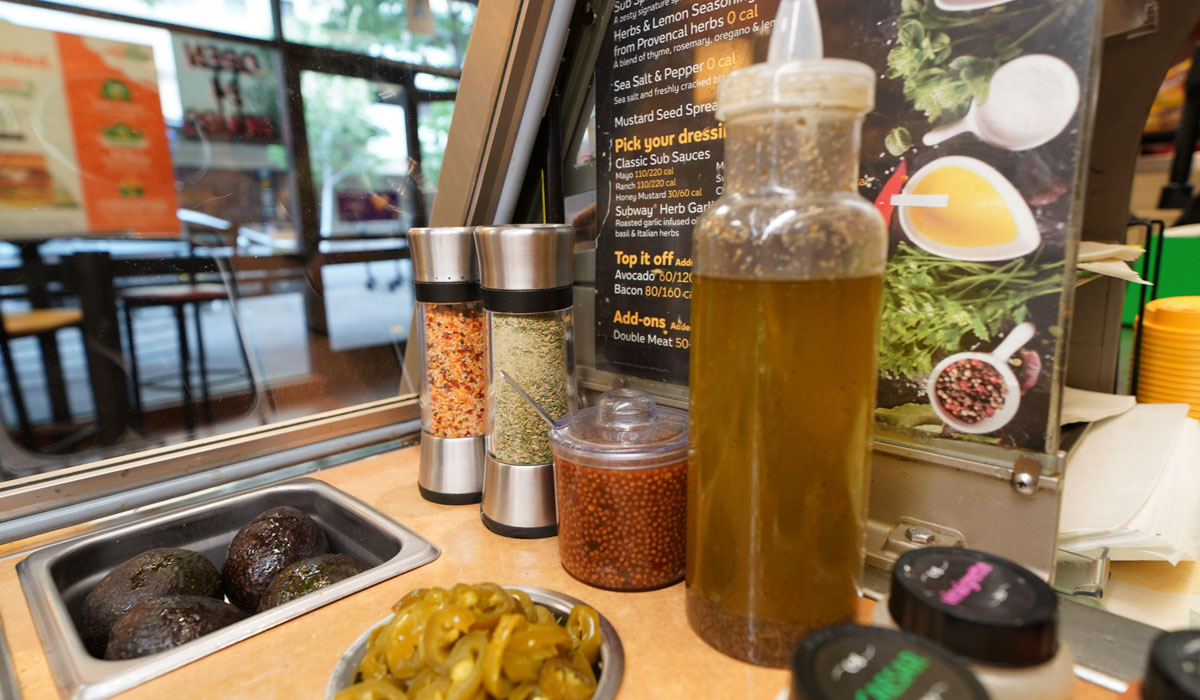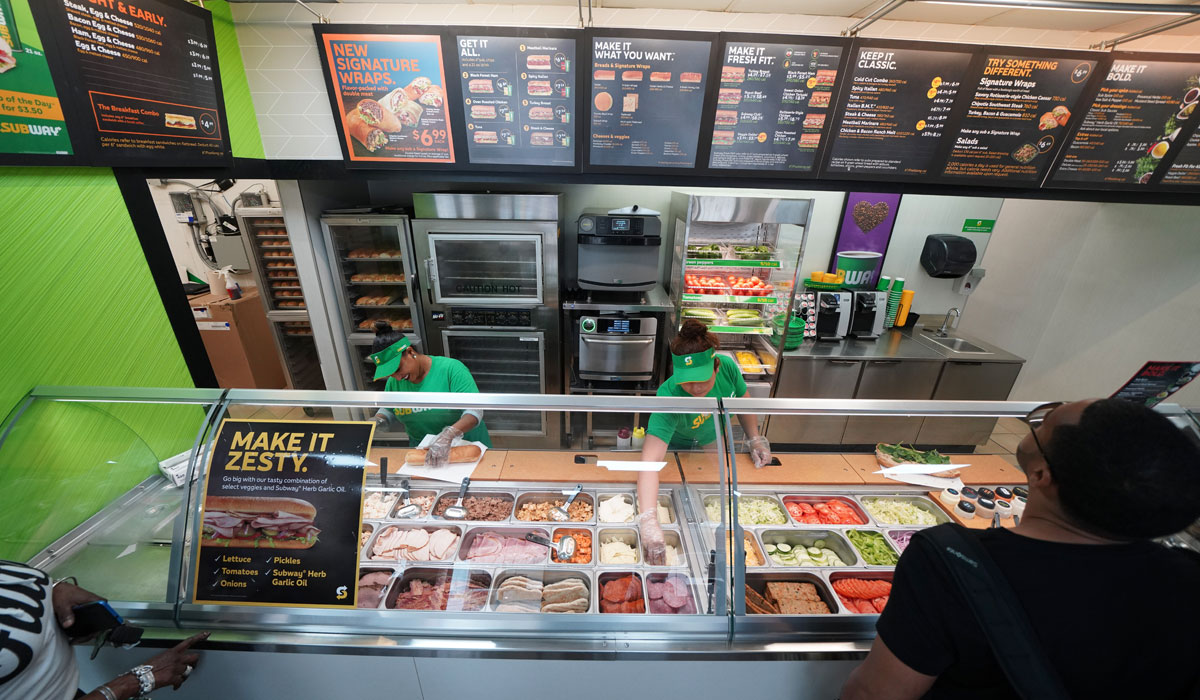What makes Subway’s closure rate in recent years so vivid is how fast the brand was growing. Before an 866-store decline from 2016–2017, Subway added 4,456 restaurants the previous six years combined. And it was steady to a point few companies could rival, if any: 816, 872, 956, 878, 778, and 145. While impressive, it’s not surprising to anybody who’s driven through just about any town in America. Subway had 27,103 domestic units at the end of 2015—more than Burger King, Wendy’s, Taco Bell, and Pizza Hut combined; 12,844 more than McDonald’s; 14,582 ahead of Starbucks. (CHECK OUT THE 32 BIGGEST FAST-FOOD CHAINS IN AMERICA)
It’s been a different narrative since, though, as Subway’s total U.S. store figure has declined by 359, 866, and 1,110 in the past three years to drop the restaurant below 25,000 stateside restaurants (24,798 at 2018 year-end). Subway hasn’t had this few locations since 2011.
There are a bevy of factors at play here, everything from a shifting consumer to more competition to Subway’s need to match real estate and trade areas with brand evolution, either via relocations or closures. A good example of this is July’s announcement the company would provide north of $100 million to franchisees to speed up its “Fresh Forward” remodel efforts. The company partnered with vendors to offer $10,000 grants to operators, about a quarter of the remodel costs, to accelerate Fresh Forward and less costly Fresh Start designs across the system.
The company said then it expected to have 10,500 U.S. locations completed by the end of 2020. To that point, roughly 1,400 global units were updated and 900 were in some form of development. Subway also spent $80 million last year to promote culinary upgrades and a more personalized guest experience via “Fresh Now,” a platform free to franchisees that quickly moved to 14 countries.
READ MORE:
The family affair of running a Subway franchising empire
Subway: We’re building a brand stronger than ever
Former Pizza Hut exec joins Subway as marketing chief
But all of this innovation, including more menu promotions than usual, unfolded against that footlong elephant in the room: Was Subway’s retraction going to continue?
This week, The New York Post reported the sandwich giant instituted a new policy requiring “mom-and-pop franchisees” who decline to renew their five-year leases to speak with a committee at Subway’s Milford, Connecticut, headquarters. Subway’s system is fully franchised.
A “former territory manager” told the publication, “the brakes are on to stop the closures. The company is coming to its senses and realizing that every store is valuable.”
Per The Post, the process starts with a one-page questionnaire and is intended to help overextended franchisees find someone else to run their restaurants. The goal being to slow the closure rate.
Sources added in the story that Subway’s 2019 rate of shut downs “appears to be on pace with last year in parts of the country.”
One question the publication raised was whether or not franchisees were eager to fill out the form. One West Coast franchisee said, “I think the form means they are putting a stake in the ground and that they don’t want to see any more stores close.”
A Subway spokeswoman added: “Subway places a tremendous value on its network of small-business owners. And as such, aims to ensure viable Subway locations remain open. We help franchise owners find buyers for their restaurants whenever possible.”

These 20-year franchisee agreements typically remain active once five-year leases end. But they’re not always strictly enforced.
Some franchisees in The Post’s article took the other angle and said these units could be hard to sell and, with the form in play, challenges could arise.
One said the questionnaire asks operators to explain what steps they’ve taken to make the store viable, local marketing, etc.
The West Coast operator noted that single-store owners who are struggling will likely just close, but owners with “20 stores may not want the hassle and will keep a losing store open.”
It will be an interesting story to track in the coming year nonetheless.
Mobile location analytics platform Placer.ai shared some Subway data with QSR to look at its foot traffic trends.
As the chart below shows, the chain produced steady performance since the beginning of 2017, with visits tracking a high level of consistency. Analyzing average monthly visits for January through September illustrates Subway experienced a loss of about 0.7 percent in traffic from 2017–2018, before seeing a rise of 1 percent in 2019.

Placer.ai’s data uncovered some interesting seasonal notes as well. Subway experienced a significant winter dip before rebounding in the spring. March consistently witnessed a peak with 2018 and 2019 traffic jumping 7.4 percent and 5.7 percent above the baseline, respectively, for the period between January 2017 and September 2019. Traffic then falls heading into April—likely due to the Easter holiday. Visits then sustain until September before decreasing through the winter.
In 2019, Subway’s summer peak was higher than normal, however. July and August traffic were 10.2 and 5.9 percent above the baseline for the period, beating out the 3.4 and 4.4 percent peaks in those year-ago measures.

This summer, Subway tested Halo Top Milkshakes at 1,000 restaurants and launched a Ciabatta collection. But the brand also rode such menu infusions as King’s Hawaiian Bread, Club Sandwiches, Signature Wraps, and Ultimate Cheesy Garlic Bread. Since, Subway has piloted Beyond Meat Subs and introduced naturally Pit-Smoked Brisket Sandwiches.
Are those year-over-year results proof some of Subway’s menu efforts are resonating? That in addition to the Fresh Now options that include new toppings and flavor and beverage stations, with offerings like Tropical Strawberry Lemonade and Pomegranate Limeade. Subway said earlier the U.S. systems would be on board sometime in the summer.
The company also noted in 2018 that its Fresh Forward U.S. stores—then live in 465 locations—were producing gross profit improvements of 11 percent and better traffic of 8 percent. And in Fresh Forward designs at relocated restaurants versus remodels, Subway saw an even steeper hike in sales and traffic—about 18 percent and 15 percent, respectively.
Naturally, Subway would like to see its overall traffic bump as the system accelerates the program. It’s why the company is forking up $100 million-plus to get there in a hurry.
Placer.ai said that data also spotlights whitespace for Subway to “further optimize the value of each location by identifying ways to reverse the seasonal trends that limit impact.” That could be mean more winter-focused product launches to incentives to other direct messaging. Regardless, “there is a huge opportunity to maximize in-store success on a per-store basis,” the company said.
Placer.ai took a look at the age-old question of rapid expansion as well—did Subway’s unheard-of growth cannibalize its reach? They looked at two Subway locations in Richmond, Virginia, and found a significant overlap of audiences. There were also two other locations in close proximity.

While a concern with dine-in traffic, naturally, it will be intriguing to see if this helps Subway satisfy off-premises demand as that trend continues to boom. The chain started delivering through multiple aggregators at 9,000 restaurants last October. Could Subway suddenly have a fortressing model in the works? And how does that affect single-unit operators? Would it benefit them?
To what extend that business shift can cover some of the brand’s transaction concerns remains to be seen. The theory, though, would be that more stores in a concentric area could lead to better delivery results—faster, higher quality. Also, a lift in carryout business from order-ahead customers who don’t want to drive far for their meal. That’s the path Domino’s is taking currently. It’s a fight, in their case, to hold share amid a contentious, discount-heavy third-party delivery environment.
What would it do for Subway? That’s a tough one to predict right now.
Overall, though, Placer.ai said, it’s a promising sign that Subway’s visit rates have remained steady amid large-scale closures, “indicating that satisfaction with the brand is still very high.”
As restaurants close or relocate, Subway might benefit from targeted expansion that helps it fight for share of stomach. And further menu innovation is almost surely on the books.
No matter how you view it, though, 2020 and beyond will be a transformative time for the world’s largest restaurant chain.







